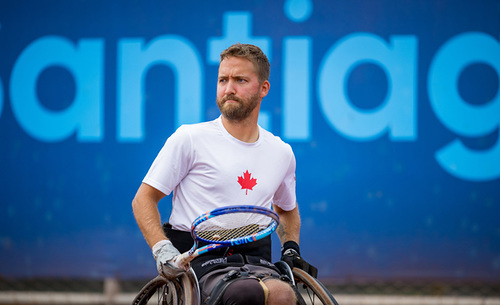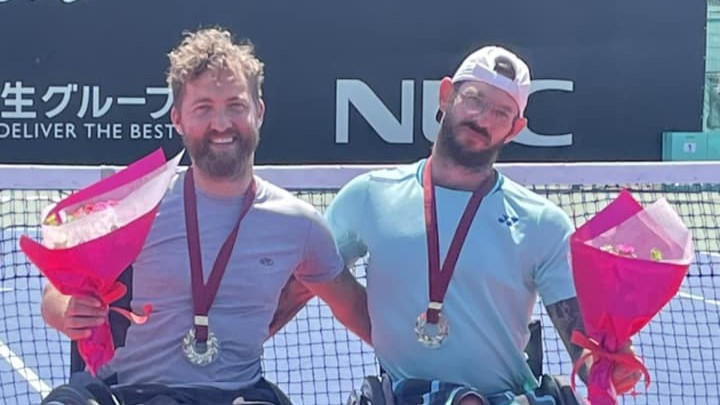
It’s all beginning to set up for Novak Djokovic in his quarter-final of all quarter-finals against Rafael Nadal on Wednesday at Roland Garros.
Djokovic is susceptible, when playing in hot humid conditions, with what is suspected to be an asthma or an asthma-like condition. The forecast for Wednesday is a very temperate 21 degrees in the afternoon and 16 degrees in the evening.
On Friday, when the semifinals will be played, those numbers change to a much more tropical 31 degrees and 28 degrees.
The element of fate at the May 22 draw ceremony – No. 6 seed Nadal being drawn to play No. 1 Djokovic in the quarter-finals – now appears to have been favourable for the Serb, who had a 50 per cent chance of potentially facing the nine-time French Open champion in Friday’s semifinals.
The 28-year-old Djokovic has lost in two of his past four Grand Slams in hot, muggy conditions – in four sets to Nadal in the French Open final a year ago and in four sets in the semifinals of the US Open last September to Kei Nishikori.
Some might wonder how he has been able to win the Australian Open where there can be the most extreme conditions of heat. But two facts explain his success – five titles Down Under over the past eight years. First, the final three rounds, when he is usually facing his toughest opposition, are played in the evening in Rod Laver Arena when the conditions are almost always moderate. Second, even if he gets an extremely hot day in the early rounds, he is generally playing inferior competition and there is not the same stress level for him.
So the climactic conditions are on his side for the match-up with Nadal. As for the Spaniard, he will be disappointed, having said on Monday, “the hotter it is, the better it is for me.”
Going in, Djokovic is clearly the form player – having won all 10 of his European clay-court matches while taking the Masters 1000 titles in Monte Carlo and Rome.
Nadal, on the other hand, has failed to win a title and has lost five times on clay (including in Rio de Janeiro in February ) – more than he did in total on clay between 2006 and 2010.
But he has looked near the peak of his uber-physical clay-court form in winning his first four rounds this year, stretching his astounding record at Roland Garros to 70-1. It really does appear, as many had speculated before Roland Garros began, that he has been able to rekindle his old sensations on the terre battue in the re-affirming and friendly confines of Paris 16ieme, and with the competitive cushion of the three-out-of-five sets format. His lone set lost was to the madcap forehand bolts of impressive 22-year-old American Jack Sock in the round-of-16.

Djokovic has not lost a set but a tweak of his groin in his second-round match against Gilles Muller was a concern.
On Monday, after a 6-1, 6-2, 6-3 dusting of Richard Gasquet, he responded with a sort of Cheshire cat grin and said “no” in answer to a question about there being any residual effects of that issue, which required an on-court treatment lasting eight minutes.
So, the stage is set for Nadal – Djokovic VII at Roland Garros. But the first three of those contests were in 2006, 2007 and 2008 when Nadal, one year older and much more experienced, was virtually untouchable on clay. Djokovic had not matured to the point he did in 2011 when he was able to overtake both Nadal and Roger Federer. The last three – 2012 (final, four sets), 2013 (semifinal, five sets) and 2014 (final, four sets) – have been high-tension, competitive affairs, with the 2013 semifinal definitely being the one that got away for Djokovic. That’s when he had a point won that would have taken him to one point away from a 5-3 lead in the fifth set – except that he touched the net in the act of putting away a shot and lost the point.
For Djokovic on Wednesday, it’s all about trying to stay on course to win his first-ever Roland Garros to complete his career Grand Slam and to fulfill a promise to his late coach Jelena Gencic that he would win the French Open for her.

For Nadal, it’s about attaining the almost impossible – winning a Grand Slam title 10 times, which is three more than modern era greats Pete Sampras and Roger Federer were able to manage with their seven titles each at Wimbledon.
It also may be his last chance to continue putting in place the building blocks to an eventual 17 career Grand Slam titles, which would tie him with Federer. The great Swiss only won one Grand Slam after age 29, the age Nadal will be on his birthday, which happens to be Wednesday.
For Nadal, currently at 14, having battled a lot more injuries, and injury-stoppages, over his career than Federer, getting another one this year in Paris could be critical to his chances of catching or overtaking his longtime rival.
The Spaniard has not won a Grand Slam other than Roland Garros, except for the 2013 US Open, since 2010.
So, la table est mise (the table is set) for a blockbuster and, with all that is at stake for both players, it’s not exaggerating to declare that there has never been a quarter-final like it in the history of tennis.
The final catch: it’s not the final and the winner will have to gather himself and go through the grind twice more in order to win the title. Djokovic is the solid consensus pick among media and former players to win Wednesday, but Nadal is probably the better bet to carry on and win the title if he is the one to emerge victorious.
Pospisil/Sock blown away

You might as well have been seaside in Deauville or St. Malo on Tuesday, the breezes and gales were worthy of a French tourist resort on the Atlantic coast.
They certainly weren’t conducive to precision tennis and Vasek Pospisil and Jack Sock were simply outplayed in the conditions by the veteran paring of Horia Tecau of Romania, 30, and Jean-Julien Rojer of the Netherlands, 33. The unflattering score was 6-3, 6-3 for the No. 5 seeds in the quarter-final encounter.
The match was often a gong show of horrendous miscues – many right near the net as the wind wildly shunted balls in the air. The simplest of put-aways became adventures as swirling gusts picked up the red brick dust and carried it off to leave broad bare patches on the court. It also got in the players’ eyes and they frequently had to stop and try to rub them to restore proper vision.
An early break of the Sock serve in the third game of the match and Rojer and Tecau had the separation they required to win the opening set. Pospisil and Sock broke in the opening game of the second set, eliciting a loud roar from Pospisil. But Sock promptly lost his serve in the following game and the No. 2 seeds unraveled from there.
There were some questionable shot selections – Sock hitting a wild bounce overhead from the baseline way long on the ultimate set point in the first set and Pospisil trying a low-percentage between-the-legs shot on the love-15 point in the sixth game when he went on to lose his serve.
And the team optics weren’t good when Sock walked out from the final changeover by himself about 20 seconds before Pospisil got up and joined him.
“It was a weird, really swirling wind,” said Canadian Davis Cup captain Martin Laurendeau. “Rojer and Tecau did well to put the ball up in the air and take the net away from Jack and Vasek.
“It was tough for Jack and Vasek to exploit their big serves in the wind, to be powerful and accurate. But the other guys played smart. They got near the net to get to the ball before the wind could really get a hold of it.”

So the Pospisil/Sock saga in 2015 ends at Roland Garros – with a quarter-final not being that disappointing with some of the obstacles they faced – principal among them being Sock’s singles run to the round-of-16 and a big match with Rafael Nadal.
Currently ranked No. 4 in the ATP individual doubles rankings, Pospisil, who lost in the first round a year ago partnering Rajeev Ram, earned 360 ranking points for reaching the quarter-finals. He should maintain a Top 5 position when next Monday’s rankings come out.
Robillard-Millette advances

Charlotte Robillard-Millette moved into the third round of the junior girls event on Tuesday, beating Tessah Andrianjafitrimo of France 6-0, 6-2 in a one-sided contest.
The 16-year-old lefthander from Blainville, Que., was pleased with her performance after admitting that nerves had affected her when she played her first-ever singles match at Roland Garros on Sunday.
It’s her second Grand Slam junior event after the Australian Open in January where she reached the quarter-finals in the same month she turned 16. “In Australia, I don’t think I was expected to do quarters,” Robillard-Millette said in fluent English on Tuesday. “I was the last one to get in the main draw. It was a good experience for me. I just took it and did my best. I was impressed I could do quarters for my first Grand Slam because I was nervous. But here I don’t think it would be a surprise if I make quarters because I’m really confident about the way I’m playing and my abilities.”

On Tuesday, her opponent Andrianjafitrimo got discouraged by the Robillard-Millette onslaught, electing to put her head under a towel at the changeovers while still leaving enough room for a swig of her drink.
The sixth-seeded Robillard-Millette faces a tough test in her third round on Wednesday, No. 12 seed Paula Badosa Gibert of Spain. Badosa Gibert, 17, has a WTA ranking of No. 270 and last month had wins over No. 87 Ana Konjuh of Croatia and No. 60 Lauren Davis of the U.S. at the WTA Premier Mandatory tournament in Madrid. (Davis had upset Genie Bouchard 6-3, 6-1 in Charleston, S.C. at the Family Circle Cup the previous month.)
“I don’t think she plays the juniors very much,” Robillard-Millette said about Babos Gibert. “It should be a good match. I’m just concentrating on myself and I’m ready to play a good match.”
Robillard-Millette’s WTA ranking is No. 802.

Like a number of players at Roland Garros, Robillard-Millette is bothered by a bit of a sore throat and a cold. “I’m not having any trouble breathing,” she said, “but sometimes I cough when I’m hitting the ball. You have to get it out.”
Her mother Josée is a florist and her father Francois, who used to play for the Montreal Concordes of the Canadian Football League, works for Hydro-Québec.
Paris… Paris… Paris…

Croissants are a staple of a Parisian breakfast – and/or a café treat – and can be a work of art in and of themselves.
The picture above shows the outside and inside of the best croissants at the Porte d’Auteuil, the Parisian neighbourhood adjacent Roland Garros. Noteworthy is how flaky the croissants are inside. Unfortunately, that’s not always the way with many of the ‘doughy’ versions found in North America.


